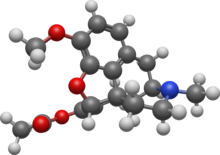Thebacon
This article needs additional citations for verification. (October 2021) |
This article needs more primary sources. (October 2021) |  |
 | |
 | |
| Clinical data | |
|---|---|
| AHFS/Drugs.com | International Drug Names |
| ATC code | |
| Legal status | |
| Legal status |
|
| Identifiers | |
| |
JSmol) | |
| |
| |
| | |
Thebacon (
semisynthetic opioid that is similar to hydrocodone and is most commonly synthesised from thebaine. Thebacon was invented in Germany in 1924, four years after the first synthesis of hydrocodone.[3] Thebacon is a derivative of acetyldihydrocodeine, where only the 6–7 double bond is saturated. Thebacon is marketed as its hydrochloride salt under the trade name Acedicon, and as its bitartrate under Diacodin and other trade names. The hydrochloride salt has a free base
conversion ratio of 0.846. Other salts used in research and other settings include thebacon's phosphate, hydrobromide, citrate, hydroiodide, and sulfate.
Medical uses
Thebacon is an
antitussive, primarily used in Europe, although it is no longer in common use.[citation needed] Currently, dihydrocodeine and nicocodeine are used as second-line codeine replacements. The other dihydromorphinone used as an antitussive is hydromorphone (Dilaudid cough syrup); the other narcotic antitussives are either more directly related to codeine or not related at all (open chain methadone relatives and thiambutenes
).
Thebacon is indicated for moderate to moderately severe pain and dry painful coughing, like hydrocodone. It has a duration of action in the range of 5 to 9 hours and doses typically start at 5 mg q6h. For both pain and coughing, thebacon can be made more effective along with
chlorpheniramine.[medical citation needed
]
Pharmacokinetics
Thebacon is most commonly taken orally as an elixir, tablet, or capsule, although rectal and
3,14-diacetyloxymorphone
.
Thebacon's
dihydrodiacetylmorphine
.
Production
Thebacon is generated by the
diacetylmorphine is produced. It is also a product of the metabolism of hydrocodone by Pseudomonas putida M10, the bacterium used for oil spill remediation. This also produces a morphinone reductase, which can turn morphine into hydromorphone in a process which produces other active opioids, such as oxymorphone, oxymorphol, or hydromorphinol
as intermediates.
Legal status
Thebacon is a
Schedule I controlled substance in the United States, never having been in medical use there.[5] The US DEA Administrative Controlled Substance Control Number assigned by the Controlled Substances Act (1970) for thebacon and all of its salts is 9315.[6]
See also
References
- ^ Anvisa (2023-03-31). "RDC Nº 784 - Listas de Substâncias Entorpecentes, Psicotrópicas, Precursoras e Outras sob Controle Especial" [Collegiate Board Resolution No. 784 - Lists of Narcotic, Psychotropic, Precursor, and Other Substances under Special Control] (in Brazilian Portuguese). Diário Oficial da União (published 2023-04-04). Archived from the original on 2023-08-03. Retrieved 2023-08-16.
- ISBN 978-0-85369-840-1.
- OCLC 1628783.
- ^ US 1731152, Schopf C, "Process for the manufacture of derivatives of dihydrocodeinone or its substitution products", assigned to Boehringer
- ^ "Controlled Substance Schedules". US Department of Justice. Archived from the original on 7 February 2011.
- ^ "Lists of: Scheduling Actions Controlled Substances Regulated Chemicals" (PDF). Diversion Control Division. U.S. Drug Enforcement Administration. pp. 59, 75, 89.
Look up thebacon in Wiktionary, the free dictionary.
